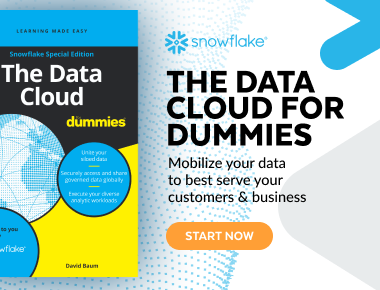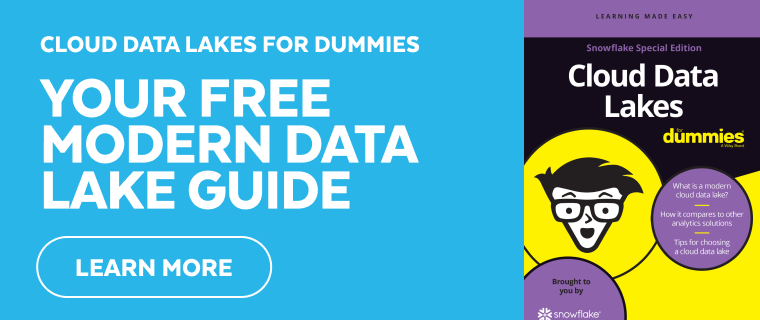Evolving Supply Chain Management with Data
In 2020, the amount of supply chain data was over 50 times greater than what was available five years prior, according to IDC research. With this exponential growth in relevant data, organizations that adopt a modern data infrastructure and analytics program have a significant competitive advantage over those still managing operations using limited data. Leveraging data to manage the supply chain ensures that customer expectations are met while maximizing profitability. Let’s look at how the supply chain is evolving and how data can address modern supply chain management challenges.
Why Supply Chain Management Must Evolve
The forces impacting today’s supply chain are dynamic, rapidly reshaping the traditional methods for how raw materials are procured and transformed into finished goods and delivered to customers. The supply chain is evolving, and supply chain management must evolve along with it. Four key drivers are spurring the need for change in supply chain management.
Increasing customer expectations
The internet has democratized consumer access to purchasing information in ways difficult to imagine just a few years ago. Smartphones make it easy to access product reviews, compare prices, and select vendors capable of delivering goods in time frames as short as a few hours. Meeting and exceeding the expectations of today’s customer requires a more resilient supply chain capable of dynamically adjusting to meet current supply demands, anticipating how changes in consumer preferences may impact future needs for products and services, and delivering finished products on time.
Pressure to maintain profitability
Profit margins can be difficult to maintain in an increasingly globalized system. Increased competition, rising inflation, and consumers’ lack of brand loyalty have conspired to squeeze manufacturers to look for new ways to reduce costs while maintaining profitability.
Intensifying scrutiny of environmental conservation and ethical labor practices
Today’s customers are more aware of the impact that their purchasing choices have on the environment and living conditions of those who extract the raw materials and create the finished goods they consume. But increasingly complex supply chains have resulted in an opaque view into how many finished goods are produced. This lack of any visibility into each stage of the supply chain represents a significant vulnerability for manufacturers and retailers that need to safeguard the reputation of their brand.
Rising global volatility
Extreme weather, political instability, pandemic outbreaks, and other macro-level events capable of causing major disruptions to global supply chains have increased the urgency for contingency planning. Manufacturers and retailers must be able to identify how these events might impact sourcing, labor, and transportation to disrupt manufacturing schedules and order fulfillment timelines.
How to Evolve Supply Chain Management Using Data
Today’s organizations are taking advantage of the massive amounts of supply chain data available to them to gain the insight needed to survive and thrive in the midst of the challenges described above. Here are four effective strategies manufacturers and retailers are using to make the most of data for supply chain management and supply chain management optimization.
Integrate all relevant data sources
Valuable supply chain data comes from countless sources, including enterprise resource planning (ERP) systems, IoT sensors, warehouse management systems, point of sale (POS) systems, and external sources. To bring all relevant data to bear, organizations must integrate data from these various sources into a single, governed repository.
Enable collaboration
Because the modern supply chain is so complex, collaboration is crucial. For example, manufacturers can integrate data from external transportation contractors, making it possible to receive advance warnings on anticipated delays in shipments of raw materials needed to keep production lines moving. Access to data from outside an organization allows manufacturers the flexibility to pivot to a new supplier with inventory, transfer existing stock from one manufacturing facility to another, and explore ways to expedite the delivery of needed materials by engaging a new shipping partner if necessary.
Automate to support human expertise
Artificial intelligence and machine learning are capable of processing and analyzing massive amounts of data to identify and flag potential issues. By analyzing data including severe weather events, political unrest, port congestion, and changes in patterns of consumption, this technology can provide decision-makers with critical lead time to execute contingency plans before production schedules or order fulfillment timelines are impacted. Data analytics programs can also be used to model product demand scenarios, allowing retailers to more accurately anticipate how many units will be required to meet subsequent consumer needs.
Ensure data infrastructure is scalable
As the sources and volume of available data continue to grow, data infrastructure must grow accordingly. To take advantage of this data, manufacturers and retailers must have cloud infrastructure capable of ingesting, processing, storing, and analyzing massive amounts of data from various sources in a variety of formats.
Snowflake for Supply Chain Management
The Snowflake Data Cloud provides manufacturers and retailers with the technology they need to maximize the value of the data available to them.
Support for diverse data sources: Gain a global real-time view of your supply chain while also leveraging local data to meet complex information requirements. Snowflake supports structured, semi-structured, and unstructured data from internal and external sources and supports secure data sharing with partners to enrich your existing data sets.
Near-infinite scalability: As data storage demands grow, Snowflake gives you the ability to store data at near-limitless volumes so you can capture and use all relevant data. Additionally, dedicated, task-specific compute resources improve the speed and efficiency of data queries.
Security and governance: Snowflake’s robust security features such as advanced user access control, dynamic data masking, and end-to-end encryption for data in transit and at rest ensure sensitive data stays protected.
Support automation and IoT: Snowflake is the ideal foundation for data applications, IoT, and many other use cases that involve automation. Snowflake’s Data Cloud for data science lets you avoid re-platforming or migrating your data unnecessarily.
Empower Your Supply Chain Management Evolution
As the modern supply chain continues to evolve, organizations that adopt a data-driven approach to supply chain management position themselves for sustainable growth. Tapping into underutilized sources of data enables manufacturers and retailers to better understand current and emerging risks, realize new efficiencies in operations and order fulfillment, and more effectively manage the customer experience.
See Snowflake’s capabilities for yourself. To give it a test drive, sign up for a free trial.

